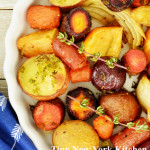Crunchy, juicy, nutrient packed jicama is an unsung hero of the produce aisle. Technically a cousin to green beans, jicama is a root vegetable from Mexico available year-round that is delicious cooked or raw. With a mild, earthy, slightly sweet flavor and an apple like consistency. It’s a great addition to salads, salsas, slaws, and grazing boards. Jicama also works as lighter swap for potatoes in baked and air fried recipes, and it’s delicious sautéed or boiled, too.
If you’ve never tried jicama, don’t be intimidated. Start by choosing one with a smooth, unblemished surface and thin brown skin. The skin should be thin enough to scrape with your thumbnail to reveal the white flesh inside. Avoid thick skinned, bruised, or shriveled jicama, which are signs of aging.
Once you’re ready to prep, start by trimming off the ends of the jicama and slice in half. Then, use a knife to gently peel away the skin.
For Jicama Sticks:
Step 1: Carefully slice off the rounded parts of the jicama, creating a flat surface.
Step 2: Cut each half into 1/4-inch slices.
Step 3: Stack slices and cut evenly into sticks.
Fresh, raw jicama sticks are a great addition to lunchboxes or served on a vegetable platter with your favorite dip. They can also add unexpected, satisfying crunch to cooked dishes, like a noodle salad with jicama and a miso vinaigrette.
Jicama sticks are delicious roasted, too. Their firm texture can withstand the heat, while the edges get golden brown and tender. Toss together with sweet peppers and spices for a simple, satisfying sheet pan side that pairs well with all kinds of meat and fish.
For Diced Jicama:
Step 1: Follow the steps above to create jicama sticks
Step 2: Line up sticks or stack into a pile, then evenly cut into cubes.
Diced jicama is a vitamin and fiber-rich way to add bulk to all kinds of green, grain, and protein-based salads. I love the combination of crunchy jicama with creamy avocado served with grilled chicken.
Moist and mild flavored jicama also plays well with fruit, especially melon. A refreshing combination of watermelon, jicama, and fresh mint falls somewhere between salad and salsa, delicious scooped onto tortilla chips or just spooned straight from the bowl.
Next time you’re at your local grocery store or market pick up jicama and experiment with ways to incorporate it into your recipes.
©Tiny New York Kitchen © 2021 All Rights Reserved
Roasting refers to proteins and vegetables cooked mostly at high temperatures in the oven. Baking uses a lower temperature to cook breads, baked goods, and casseroles.
Roasting makes any vegetable taste better. It brings out their flavor, caramelizes their natural sugars, and adds crunch. If your family doesn’t love certain vegetables like broccoli or Brussels sprouts, roasting is a great way to change their mind. Double what you’re roasting and then turn extra servings into quick meals later in the week. Cooking a little extra with one meal lets you make the most of value-sized packages of proteins and other store sales. With leftover already planned, you won’t need to lean on takeout.
Why we love to roast:
It’s Affordable! Inexpensive ingredients are tastiest when roasted. Root vegetables are browned and crisp, tomatoes and grapes are extra juicy and sweet, and tough cuts of beef are fall-apart tender. You also don’t need any special equipment to roast.
Roasting Is Healthful! Roasted foods need very little fat to cook compared to frying or sautéing. Roasting also intensifies flavors without added salt, sugar, or other ingredients.
It’s Easy! Roasted foods need little prep before they cook. And once the oven door closes, you can walk away. Fewer pans and utensils are needed, making cleanup easier too.
Essential Tools For Roasting:
Rimmed Sheet Pan: The rim keeps vegetables from falling off the sides and catches any juices from meats and fish.
Oven-Save Skillet: Go from stovetop to oven and back. Sear meats before roasting or make a pan sauce with the meat drippings after roasting.
Roasting Pan: Best for large roasts, hams, and turkeys. An inner rack lifts the meat so it can brown and crisp underneath.
Parchment Paper: Line pans to keep foods from burning and sticking, then toss for easy cleanup. If roasting at a higher temp or broiling use foil.
Metal Tongs: Flip and stir foods on a hot pan with ease. Look for tongs with a heat resistant grip.
Silicone Brush: Brush on a sticky glaze or baste foods with sauce. The silicone bristles are easy to clean.
Tips For Sheet Pan Roasting:
Jump Start Browning by preheating your sheet pan before adding vegetables.
Pat foods very dry with paper towels so the outside browns while the inside cooks through.
Cut foods to the same size and thickness so smaller pieces don’t burn.
Space out foods on the sheet pan so they have room to crisp and brown.
Let sheet pans cool before rinsing to keep the metal from warping.
©Tiny New York Kitchen © 2021 All Rights Reserved
This fall Tiny New York Kitchen celebrates sweet parsnips, earthy beets, and mild turnips. These root vegetables offer flavor, nutrition, and versatility.
Look for root vegetables that are firm to the touch with smooth, blemish-free skin. If there are any greens attached, make sure they look fresh, not wilted.
Before storing parsnips, beets, and turnips, remove any greens and brush off any dirt. Wrap in a damp paper towel, place in a plastic bag, and store in the refrigerator crisper; most roots will last up to two weeks.
Root vegetables absorb nutrients from the soil they grow in, including antioxidants, iron, and vitamins A, B, and C. They also provide fiber, which helps you feel fuller longer. To maximize your fiber intake, leave the skin on and give parsnips and carrots a good scrub instead.
Parsnips: These pale, carrot-like root vegetables are sweet and earthy. They can be roasted, sautéed, mashed, and puréed. Choose small to medium parsnips, since larger ones can be woody.
Beets: Beets can be red, golden, or striped. Whether roasted, boiled, or steamed, they’re slow to cook, but packaged precooked versions are also an option. You can even enjoy beets raw. Simply peel and grate or thinly slice.
Turnips: Creamy white with pinkish-purple tops, turnips turn mellow and tender when cooked. Try them roasted, sautéed, mashed, or added to soups and stews.
Greens: If you’re lucky, your beets and turnips will have greens attached. These edible, nutritious, and delicious greens should always be removed for storage, as they pull moisture from the root ends. Wash the greens and use to make pesto, or sauté with garlic and oil for a quick side dish or simple pasta.
“Work With What You Got!”
©Tiny New York Kitchen © 2018 All Rights Reserved
Everything From Apple Sauce To Tzimmes!
For a Sensational Seder you’ll want to have these traditional Passover dishes on hand.
Coconut Macaroons (You’ll Go Coco-Loco For Coconut Macaroons!)
Haroseth (For A Sweet Seder)
Matzo Ball Soup (Keep Your Eye On the Matzo Ball)
Potato Kugel (When Life Gives You Potatoes, Have Kugel)
Apple Sauce (Passover’s Special Sauce For Latkes & More)
Chopped Chicken Liver (What Am I? A Great Topper For Matzo!)
Kosher Passover Soups (A.K.A. Jewish Penicillin)
Karpas (That’s Parsley, For The Gentiles)
Matzo (You Gotsa Have Lotsa Matzo On Passover)
Root Vegetable Tzimmes (Get In Touch With Your Roots!)
Honey Glazed Carrots (Yummy)
Gefilte Fish (Just Like Your Grandmother Used To Make)
Kedem Concord Grape Juice (Tasty Enough For All Four Cups)
Raspberry Jelly Ring (If It’s Kosher, You Shoulda Put A Jelly Ring On It!)
Honey (Make A Nod To The Land Of Milk & Honey)
Beitzah (Don’t Forget The Eggs!)
Whole Kosher Brisket (Braise With Onions & Make Your Bubbe Proud)
Leg Of Lamb (Get A Leg Up On Seder Dinner)
Flourless Cake With Chocolate Glaze (Because 8 Days Without Cake Is A Long Time)
“Work With What You Got!”
© Victoria Hart Glavin Tiny New York Kitchen © 2016 All Rights Reserved














